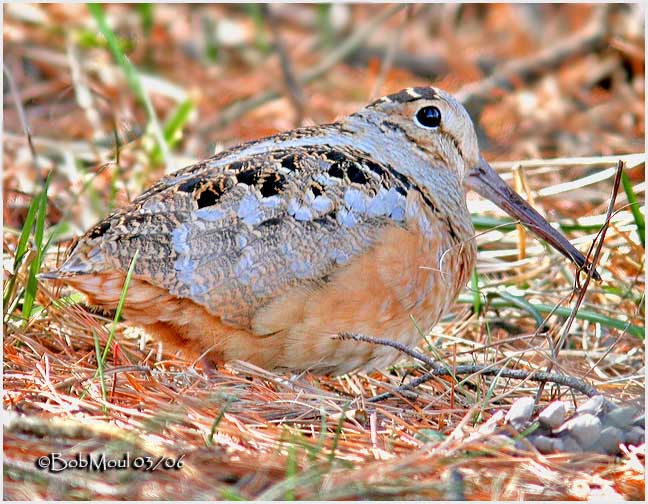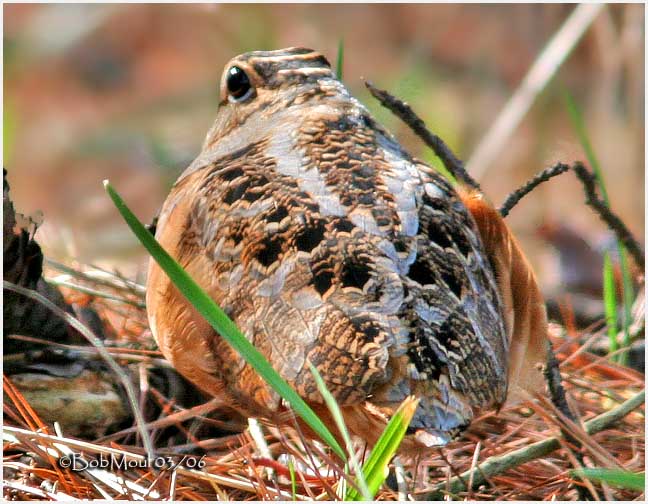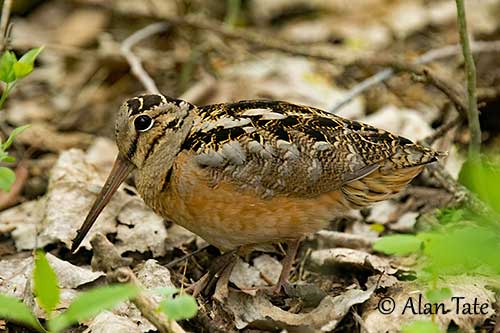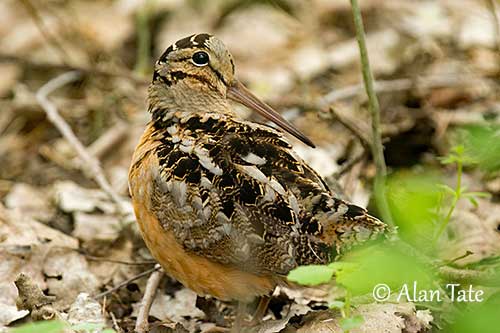
American Woodcock
Scolopax minor
Charadriiformes Order - Scolopacidae Family
BIOMETRICS:
Length: 25-31 cm; Wingspan: 42-48 cm; Weight: 115-280 g
LONGEVITY: up to 8 years
DESCRIPTION:
American Woodcock is a compact bird, with long bill. It has barred crown. Plumage is mottled brown, tawny and grey, and allows it to hide in its habitat. Underparts are pale cinnamon.
Neck is very short. Nape is black barred with whitish lines. Face is pale buff, with dark eye line and auricular stripe. American Woodcock has large dark eyes, almost on the back of the head, allowing rear view binocular vision.
American Woodcock has pinkish short legs. It is short-tailed and it has broad and rounded wings.
Both sexes are similar, with female larger than male.
Juveniles resemble adults, but duller.

VOICE: SOUNDS BY XENO-CANTO
American Woodcock’s call is a loud nasal “peent”, mostly in spring. Female is silent. When male is flying during courtship displays, we can hear a variety of twittering songs, produced vocally, but also by air over wing feathers. This “melody” increases as it rises.
HABITAT:
American Woodcock nests in moist woodlands. We can find it in open fields and wet thickets, and brushy swamps.
RANGE:
American Woodcock breeds from Manitoba to Newfoundland, and southwards, from Texas to northern Florida.
It winters from Connecticut and Missouri to Gulf Coast and southern Florida.
BEHAVIOUR:
American Woodcock feeds on the ground, searching for worms. This bird has a long bill, with a flexible tip, allowing feeling worms while probing in the ground. American Woodcock walks around and the action of its voluntary heavy steps make worms move around and it is easier to detect them. It locates its prey by hearing, and feeling vibrations through the bill.

Fr: Bécasse d’Amérique
All : Kanadaschnepfe
Esp : Chocha Americana
Ital : Beccaccia americana
Nd : Amerikaanse Houtsnip
Sd : Amerikansk morkulla
Photographers:
Bob Moul
Nature Photography
Alan & Ann Tate
AA Bird Photography
Text by Nicole Bouglouan
Sources :
FIELD GUIDE TO THE BIRDS OF NORTH AMERICA - National Geographic Society - ISBN: 0792274512
All About Birds (Cornell Lab of Ornithology)
Animal Diversity Web (University of Michigan Museum of Zoology)
What Bird-The ultimate Bird Guide (Mitchell Waite)
Wikipedia (Wikipedia, The Free Encyclopedia)
REPRODUCTION:
American Woodcock’s nest is a scrape in the ground. Female builds it alone, and lines it with dead leaves. Nest is situated in open woods or in bushy fields. The cryptic plumage serves as camouflage among vegetation.
Female lays 3 to 5 grey-orange eggs. Incubation lasts about 20 to 22 days, by female alone.
Precocial chicks may leave the nest a few hours after hatching, but female feeds them for the first week. They begin to probe for food very quickly after hatching. They fledge at about two weeks, but they become independent at about 5 weeks of age. They reach their sexual maturity at about one year.
This species produces only one clutch per season.
DIET:
American Woodcock feeds mainly on invertebrates such as earthworms, beetles, flies and insect larvae. They may consume some seeds, but not much.
PROTECTION / THREATS / STATUS:
American Woodcock are popular game birds, and great numbers of these birds are killed every year.
Because they nest on the ground, adults and chicks are attacked by mammals, and the snakes eat the eggs.
During migration, numerous collisions with vehicles, wires, towers… kill several birds.
They also are threatened by the use of pesticides for insect control.
Populations have declined some decades ago, but it is difficult to evaluate Woodcock numbers.

American Woodcock feeds solitary, by day in spring and summer, and mostly at night in winter. They migrate alone or in small groups, and at night. They may stop in city parks and suburban areas (yards, orchards) during migration.
Male performs a beautiful courtship display, which may start on wintering areas. It performs flight displays, a “sky dance”, at dusk and dawn. Its flights include spiral up high up to 100 metres, with fluttering wings while it is chirping, and circle back to the ground as a falling leave, uttering its “peent” calls. Males perform these displays to attract females, and this behaviour takes place in “singing sites” or “breeding fields”, each male coming back in the same places. Male may repeat these displays 10 to 20 times during an evening.
After these displays, females choose males. They are polygamous, and females care for the young alone. If the young are threatened, female may perform a display, feigning an injury to draw the intruder away from the nest.
FLIGHT:
American Woodcock performs a beautiful flight display, flying upwards in a wide spiral. Then, wings twitter before the bird starts to descend in a diving manner. American Woodcocks migrate at night, flying in loose flocks at low altitudes. They are short distance migrants.
